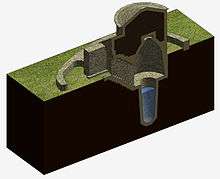Nuragic holy well

The nuragic holy well is a typical Sardinian hypogean structure designed, during the Bronze Age, to the worship of the waters. Scattered throughout the island, along the Giants' grave and the megaron temples, they testify the deep religiosity of the Nuragic populations. These temples were a place of pilgrimage and ceremonies: it is believed that in certain times of the year the various nuragic populations of the area gather together in their vicinity.
The oldest temples were built in the style of the nuraghe, with blocks of stone not perfectly squared; over time they were built with a greater accuracy. The most common type is composed of a circular well, built with blocks of stone, which was accessed through the steps that from the surface reach the water level.[1] They are a clear example of the architectural mastery of the nuragics and confirm the great importance given by them to water sources.
In the past it was thought that they were built between the eighth and sixth centuries BC; the latest findings, however, have led archaeologists to estimate that the temples goes back at the time when there was a close relationship between the Mycenaean kingdoms, Crete and Sardinia (around 1300 BC). An almost certain dating comes from recent excavations in the Holy Well of Funtana Coberta, near Ballao, which lack completely Iron Age nuragic ceramics, while there are finds from the Aegean. The Well of Ballao was probably built in the late Bronze Age and abandoned some centuries later.
Image gallery
-

Reconstruction of the holy well of Funtana Coberta
-
Tholoi of the Funtana Coberta well
-
Sa Testa, Olbia
-

Santa Cristina holy well (section), Paulilatino
-

Santa Cristina
Notes
- ↑ Pozzi Sacri, il portale sardo(Italian)
Bibliography
- G Lilliu: Sardegna Nuragica, Edizioni Il Maestrale, 2006, ISBN 88-89801-11-5
- A.Moravetti: Il santuario nuragico di Santa Cristina; Editore Carlo Delfino, ISBN 88-7138-294-3,
- R.Pettazzoni, La religione primitiva in Sardegna, 1912, Società Editrice Pontremolese, Cagliari Biblioteca Nazionale .
- M. A. Fadda, F. Posi: Il villaggio nuragico Su Romanzesu, Editore Carlo Delfino, 2006, .
- Demurtas S. U. Manca Demurtas L. Santa Cristina e i siti archeologici nel territorio di Paulilatino 1999.
- Pitzalis G.: Il pozzo sacro di Predio Canopoli. Bollettino di Archeologia Perfugas. 1991.
- Lilliu, G. La civiltà dei Sardi dal neolitico all'età dei nuraghi. Torino - Edizioni ERI - 1967.
- Puddu M. G.: Recenti sondaggi di scavo a Santa Vittoria di Serri, in: La Sardegna nel Mediterraneo fra il Bronzo Medio e il Bronzo Recente. Atti del III Convegno di Studi.
- Lilliu G. Sculture della Sardegna nuragica Verona 1962.
- Aa.Vv., Ichnussa. La Sardegna dalle origini all'età classica - Milano, 1981.
- Paolo Melis: Nuraghenkultur 2003. ISBN 88-7138-276-5.
- Maria Rosaria Manunza (a cura di): Funtana Coberta. Tempio nuragico a Ballao nel Gerrei; ISBN 88-8775-82-04.